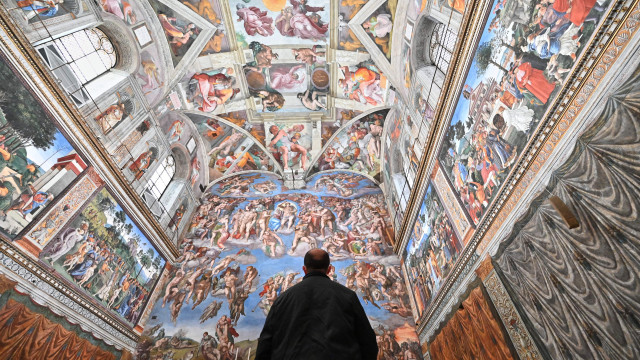





























See Also
See Again
© Shutterstock
0 / 30 Fotos
Our life-giver and destroyer
- Our sun is a glowing cauldron of gas that produces the heat and light we need to survive. It releases energy by turning hydrogen into helium, but the sun is already halfway through its life. When the hydrogen runs out in a few billion years, the sun will expand to form a monstrous red giant star.
© Shutterstock
1 / 30 Fotos
A slow death of Earth
- Once the sun enters its red giant phase in about five billion years, it may swell enough to devour Mercury, Venus, and possibly Earth. Or at the very least, our planet will be fried to a crisp as the oceans boil and the surface is sterilized with incredible amounts of UV light.
© Shutterstock
2 / 30 Fotos
A nebular legacy
- As the red giant expels its remaining layers out into space, it forms a planetary nebula (an ethereal, glowing shell of gas) while the dense, burnt-out core is left behind as a white dwarf, glowing faintly in the dark.
© Shutterstock
3 / 30 Fotos
Rogue planets
- Without the sun’s gravitational pull, the remaining planets in the solar system will be cast adrift into the cosmic dark, becoming rogue planets: worlds without a star, traveling the void, untouched and alone.
© Shutterstock
4 / 30 Fotos
The galaxy’s inevitable merger
- Billions of years after the death of our solar system, our Milky Way will collide and merge with the Andromeda galaxy in a majestic but chaotic gravitational interaction that will forever alter the face of our galactic home. But what about the scale of our entire universe?
© Shutterstock
5 / 30 Fotos
An explosive beginning
- The Big Bang, which occurred nearly 14 billion years ago, marked the birth of space and time. It began as an unimaginably hot, dense singularity that exploded and expanded into the vast cosmos we observe today.
© Shutterstock
6 / 30 Fotos
Cosmic expansion
- Since the Big Bang, the universe has been constantly expanding. This expansion is central to all major end-of-universe theories, as it determines whether the cosmos will stretch forever, collapse, or tear itself apart.
© Shutterstock
7 / 30 Fotos
Dark energy
- Discovered through observations of distant supernovae, dark energy appears to be pushing the universe apart at an accelerating rate. It remains the biggest unknown variable in determining how the universe might eventually end.
© Shutterstock
8 / 30 Fotos
The Big Freeze
- If the expansion of the universe continues indefinitely, stars will burn out, galaxies will separate, and temperatures will plummet toward absolute zero. This quiet, bleak scenario is known as the Big Freeze, or heat death of the universe.
© Shutterstock
9 / 30 Fotos
Cosmic silence
- According to the second law of thermodynamics, entropy (disorder and randomness) always increases. Eventually, energy will spread so thin that no processes can occur, and the universe will become dead, motionless, and cold.
© Shutterstock
10 / 30 Fotos
The Big Rip
- Another theory of how the universe will end is that as dark energy becomes stronger over time it could tear galaxies, stars, planets, and even atoms apart. This theoretical scenario, known as the Big Rip, predicts a violent unraveling of the fabric of space.
© Shutterstock
11 / 30 Fotos
Phantom energy
- A variant of the Big Rip, phantom energy involves a form of dark energy with ultra-negative pressure. Unlike regular dark energy, which causes expansion to accelerate, phantom energy could grow stronger over time. This could happen so powerfully that it eventually overcomes all forces, tearing galaxies, stars, planets, and even atoms apart.
© Shutterstock
12 / 30 Fotos
The Big Crunch
- Opposite of the Big Freeze, the Big Crunch theory proposes that the expansion of the universe will eventually stop and reverse. Gravity would pull everything back together, ending in a catastrophic collapse.
© Shutterstock
13 / 30 Fotos
The Big Bounce
- The scientific theory known as the Big Bounce suggests the universe might contract in a Big Crunch, and then rebound into a new expansion and a new Big Bang. This would sidestep singularities and keep cosmic history in perpetual motion.
© Shutterstock
14 / 30 Fotos
Vacuum decay
- Quantum mechanics allows for the terrifying possibility of vacuum decay. The universe currently exists in what can be considered a "false vacuum" (a stable but not the most stable state). If it were to suddenly transition to a lower-energy “true vacuum,” it would expand at light speed, rewrite the laws of physics, and obliterate everything without warning.
© Shutterstock
15 / 30 Fotos
Cosmic background radiation
- The cosmic microwave background, a relic of the Big Bang, is already cooling. Over time, it will become undetectable, and so the universe will be left without any echo of its explosive birth.
© Getty Images
16 / 30 Fotos
The decay of atoms
- Proton decay, a hypothetical process predicted by some grand unified theories, could mean that all matter in the universe eventually disintegrates into subatomic particles. If true, even the atoms of stars and planets will vanish.
© Shutterstock
17 / 30 Fotos
Fading beyond visibility
- Eventually, galaxies will accelerate beyond our ability to see them. Their light won’t reach us anymore, as they accelerate at the speed of light. This will shrink the observable universe until only local remnants remain visible.
© Shutterstock
18 / 30 Fotos
The fading of stars
- One thing is certain, though: over trillions of years, stars across the universe will exhaust their hydrogen fuel and morph into far stranger things. Galaxies will grow darker as new star formation dwindles to nothing.
© Getty Images
19 / 30 Fotos
The last cosmic citizens
- After all stars die, the only thing left behind will be exotic objects: black holes, neutron stars, and black dwarfs. These remnants will quietly populate the deepening night, whispering of a once-vibrant cosmos.
© Shutterstock
20 / 30 Fotos
The long reign of black holes
- Thanks to their immense mass and gravity, black holes are expected to outlive everything else, and will hold dominion over an empty universe long after stars and matter have disappeared.
© Shutterstock
21 / 30 Fotos
Cosmic evaporation
- Theoretical physicist Stephen Hawking proposed that black holes emit faint radiation, which causes them to slowly lose mass. Over vast durations, even these titans will evaporate completely, which will bring an end to the chapter of structure in the physical realm.
© Shutterstock
22 / 30 Fotos
The dawn of stillness
- Once black holes vanish, no organized matter will remain. The universe becomes a blank canvas, devoid of light or form, and its energy is far too diffused to create or sustain anything. Nothing happens for eternity.
© Public Domain
23 / 30 Fotos
Quantum fluctuations
- Tiny energy fluctuations in empty space could spontaneously trigger a new universe. Although this is entirely speculative, scientists are positive that is possible for rebirth to occur. It would essentially be a new Big Bang from the ashes of the last.
© Shutterstock
24 / 30 Fotos
Dissolution of space-time
- But if underlying quantum fields change or degrade, space-time itself might not endure forever. In some theories, the very fabric of reality could unravel, leaving behind a realm with no time, space, or matter.
© Shutterstock
25 / 30 Fotos
Multiverse ideas
- If the multiverse exists, our universe might be just one bubble among many. In some alternate universes, life could thrive long after our universe dies. Universes could also collide with one another, altering or annihilating their contents.
© Shutterstock
26 / 30 Fotos
A changing cosmic perspective
- Future discoveries may fundamentally shift our view of the universe. Theories we take as truth today might be mere stepping stones toward revelations that rewrite reality entirely. Only time will tell how these possibilities unfold.
© Shutterstock
27 / 30 Fotos
So much time, so much to do
- Despite these daunting futures, their remoteness leaves us with plenty of time to explore, discover, and marvel. The death of the universe is not a reason to despair, but rather it can be used as a prompt to wonder and remain in awe of the cosmos.
© Shutterstock
28 / 30 Fotos
The end of the universe
- Given how vast the timescales of the future will be and our own observational limits, we may never actually witness the universe’s final chapter. Its end might arrive in a form so foreign that we wouldn’t recognize it even if we could. Sources: (Royal Museums Greenwich) (Natural History Magazine) (National Geographic) See also: Time-lapse of the future: what the universe will look like
© Shutterstock
29 / 30 Fotos
© Shutterstock
0 / 30 Fotos
Our life-giver and destroyer
- Our sun is a glowing cauldron of gas that produces the heat and light we need to survive. It releases energy by turning hydrogen into helium, but the sun is already halfway through its life. When the hydrogen runs out in a few billion years, the sun will expand to form a monstrous red giant star.
© Shutterstock
1 / 30 Fotos
A slow death of Earth
- Once the sun enters its red giant phase in about five billion years, it may swell enough to devour Mercury, Venus, and possibly Earth. Or at the very least, our planet will be fried to a crisp as the oceans boil and the surface is sterilized with incredible amounts of UV light.
© Shutterstock
2 / 30 Fotos
A nebular legacy
- As the red giant expels its remaining layers out into space, it forms a planetary nebula (an ethereal, glowing shell of gas) while the dense, burnt-out core is left behind as a white dwarf, glowing faintly in the dark.
© Shutterstock
3 / 30 Fotos
Rogue planets
- Without the sun’s gravitational pull, the remaining planets in the solar system will be cast adrift into the cosmic dark, becoming rogue planets: worlds without a star, traveling the void, untouched and alone.
© Shutterstock
4 / 30 Fotos
The galaxy’s inevitable merger
- Billions of years after the death of our solar system, our Milky Way will collide and merge with the Andromeda galaxy in a majestic but chaotic gravitational interaction that will forever alter the face of our galactic home. But what about the scale of our entire universe?
© Shutterstock
5 / 30 Fotos
An explosive beginning
- The Big Bang, which occurred nearly 14 billion years ago, marked the birth of space and time. It began as an unimaginably hot, dense singularity that exploded and expanded into the vast cosmos we observe today.
© Shutterstock
6 / 30 Fotos
Cosmic expansion
- Since the Big Bang, the universe has been constantly expanding. This expansion is central to all major end-of-universe theories, as it determines whether the cosmos will stretch forever, collapse, or tear itself apart.
© Shutterstock
7 / 30 Fotos
Dark energy
- Discovered through observations of distant supernovae, dark energy appears to be pushing the universe apart at an accelerating rate. It remains the biggest unknown variable in determining how the universe might eventually end.
© Shutterstock
8 / 30 Fotos
The Big Freeze
- If the expansion of the universe continues indefinitely, stars will burn out, galaxies will separate, and temperatures will plummet toward absolute zero. This quiet, bleak scenario is known as the Big Freeze, or heat death of the universe.
© Shutterstock
9 / 30 Fotos
Cosmic silence
- According to the second law of thermodynamics, entropy (disorder and randomness) always increases. Eventually, energy will spread so thin that no processes can occur, and the universe will become dead, motionless, and cold.
© Shutterstock
10 / 30 Fotos
The Big Rip
- Another theory of how the universe will end is that as dark energy becomes stronger over time it could tear galaxies, stars, planets, and even atoms apart. This theoretical scenario, known as the Big Rip, predicts a violent unraveling of the fabric of space.
© Shutterstock
11 / 30 Fotos
Phantom energy
- A variant of the Big Rip, phantom energy involves a form of dark energy with ultra-negative pressure. Unlike regular dark energy, which causes expansion to accelerate, phantom energy could grow stronger over time. This could happen so powerfully that it eventually overcomes all forces, tearing galaxies, stars, planets, and even atoms apart.
© Shutterstock
12 / 30 Fotos
The Big Crunch
- Opposite of the Big Freeze, the Big Crunch theory proposes that the expansion of the universe will eventually stop and reverse. Gravity would pull everything back together, ending in a catastrophic collapse.
© Shutterstock
13 / 30 Fotos
The Big Bounce
- The scientific theory known as the Big Bounce suggests the universe might contract in a Big Crunch, and then rebound into a new expansion and a new Big Bang. This would sidestep singularities and keep cosmic history in perpetual motion.
© Shutterstock
14 / 30 Fotos
Vacuum decay
- Quantum mechanics allows for the terrifying possibility of vacuum decay. The universe currently exists in what can be considered a "false vacuum" (a stable but not the most stable state). If it were to suddenly transition to a lower-energy “true vacuum,” it would expand at light speed, rewrite the laws of physics, and obliterate everything without warning.
© Shutterstock
15 / 30 Fotos
Cosmic background radiation
- The cosmic microwave background, a relic of the Big Bang, is already cooling. Over time, it will become undetectable, and so the universe will be left without any echo of its explosive birth.
© Getty Images
16 / 30 Fotos
The decay of atoms
- Proton decay, a hypothetical process predicted by some grand unified theories, could mean that all matter in the universe eventually disintegrates into subatomic particles. If true, even the atoms of stars and planets will vanish.
© Shutterstock
17 / 30 Fotos
Fading beyond visibility
- Eventually, galaxies will accelerate beyond our ability to see them. Their light won’t reach us anymore, as they accelerate at the speed of light. This will shrink the observable universe until only local remnants remain visible.
© Shutterstock
18 / 30 Fotos
The fading of stars
- One thing is certain, though: over trillions of years, stars across the universe will exhaust their hydrogen fuel and morph into far stranger things. Galaxies will grow darker as new star formation dwindles to nothing.
© Getty Images
19 / 30 Fotos
The last cosmic citizens
- After all stars die, the only thing left behind will be exotic objects: black holes, neutron stars, and black dwarfs. These remnants will quietly populate the deepening night, whispering of a once-vibrant cosmos.
© Shutterstock
20 / 30 Fotos
The long reign of black holes
- Thanks to their immense mass and gravity, black holes are expected to outlive everything else, and will hold dominion over an empty universe long after stars and matter have disappeared.
© Shutterstock
21 / 30 Fotos
Cosmic evaporation
- Theoretical physicist Stephen Hawking proposed that black holes emit faint radiation, which causes them to slowly lose mass. Over vast durations, even these titans will evaporate completely, which will bring an end to the chapter of structure in the physical realm.
© Shutterstock
22 / 30 Fotos
The dawn of stillness
- Once black holes vanish, no organized matter will remain. The universe becomes a blank canvas, devoid of light or form, and its energy is far too diffused to create or sustain anything. Nothing happens for eternity.
© Public Domain
23 / 30 Fotos
Quantum fluctuations
- Tiny energy fluctuations in empty space could spontaneously trigger a new universe. Although this is entirely speculative, scientists are positive that is possible for rebirth to occur. It would essentially be a new Big Bang from the ashes of the last.
© Shutterstock
24 / 30 Fotos
Dissolution of space-time
- But if underlying quantum fields change or degrade, space-time itself might not endure forever. In some theories, the very fabric of reality could unravel, leaving behind a realm with no time, space, or matter.
© Shutterstock
25 / 30 Fotos
Multiverse ideas
- If the multiverse exists, our universe might be just one bubble among many. In some alternate universes, life could thrive long after our universe dies. Universes could also collide with one another, altering or annihilating their contents.
© Shutterstock
26 / 30 Fotos
A changing cosmic perspective
- Future discoveries may fundamentally shift our view of the universe. Theories we take as truth today might be mere stepping stones toward revelations that rewrite reality entirely. Only time will tell how these possibilities unfold.
© Shutterstock
27 / 30 Fotos
So much time, so much to do
- Despite these daunting futures, their remoteness leaves us with plenty of time to explore, discover, and marvel. The death of the universe is not a reason to despair, but rather it can be used as a prompt to wonder and remain in awe of the cosmos.
© Shutterstock
28 / 30 Fotos
The end of the universe
- Given how vast the timescales of the future will be and our own observational limits, we may never actually witness the universe’s final chapter. Its end might arrive in a form so foreign that we wouldn’t recognize it even if we could. Sources: (Royal Museums Greenwich) (Natural History Magazine) (National Geographic) See also: Time-lapse of the future: what the universe will look like
© Shutterstock
29 / 30 Fotos
How will the universe end?
Nothing lasts forever, not even the universe itself
© <p>Shutterstock</p>
Some say the world will end in fire, some say in ice, but scientists are more sure than ever before as to what that answer might be. In the grand theater of existence, the curtain has only just risen on our species, yet already we find ourselves drawn to the ultimate question: how will it all end?
From the slow death of our sun to the violent shattering of galaxies, from drifting planets cast loose into endless night to theories of bouncing universes, cosmologists have traced paths through time that lead to dazzling and terrifying possibilities. Some conclusions are grounded in the laws of physics, others in speculative frontiers of theory, but all reveal a universe that is far from static, and far from safe.
So, whether you find comfort in the slow fade of a cosmic freeze or terror in the chaos of a fiery demise, click through this gallery to see how our universe may or may not see its end.
RECOMMENDED FOR YOU




































MOST READ
- Last Hour
- Last Day
- Last Week








